Project Blue Launches Kickstarter Campaign To Photograph Earth-Like Alien Planets

“From this distant vantage point, the Earth might not seem of any particular interest. But for us, it’s different. Consider again that dot. That’s here. That’s home,” American astronomer Carl Sagan once said while talking about the now-famous “Pale Blue Dot” image of Earth taken by the Voyager 1 space probe from the edge of the solar system. Now, an international consortium of scientists wants to take another pale blue dot image — this time of an alien planet.
On Tuesday, Project Blue — a privately funded mission announced last month — launched a crowdfunding campaign to help build a space telescope that would allow them to take such a photograph. Specifically, the project aims to initially raise $1 million by Dec. 21 to fund analysis, design and simulations for a telescope optimized to photograph planets in the Alpha Centauri star system — Earth’s closest stellar neighbor.
“By optimizing our telescope to focus on just Alpha Centauri, the final cost of our mission will be under $50 million, with an initial target of $25 million. Sounds like a lot, but it’s modest compared to large survey missions like NASA’s Kepler mission ($600 million) or the James Webb Space Telescope (est. $8 billion),” the project, led by Jon Morse — former NASA director of astrophysics and the CEO of BoldlyGo Institute — said in a statement on its Kickstarter page.
The low-cost telescope, which researchers associated with the project say would be roughly the size of a refrigerator, will be put in orbit around Earth for a period of two years — from late 2019 to early 2022. During this period, the telescope will use its coronagraph technology to directly photograph any planets around the Alpha Centauri star system. If the planets appear blue, it would indicate the presence of oceans and an atmosphere — things that are key to support and sustain life as we know it.
“Our telescope is small enough to fit on a coffee table, but powerful enough to pick up a planet over a billion times dimmer than its star — from four light years away! That’s like seeing a tiny firefly buzzing around a lighthouse from ten miles away,” Project Blue said in the statement.
So far, astronomers have, using Kepler’s space telescope, confirmed the existence of over 2,300 exoplanets. Of these, the planet that is believed to be the most Earth-like is Proxima b, which orbits Proxima Centauri — the third star in the Alpha Centauri star system.
“We're at an incredible moment in history, where for the first time, we have the technology to actually find another Earth,” Morse told Space.com. “Just as exciting — thanks to the power of crowdfunding — we can open this mission to everyone.”
By 12:56 a.m. EDT Wednesday, the campaign had raised just over $40,100.
© Copyright IBTimes 2025. All rights reserved.






















